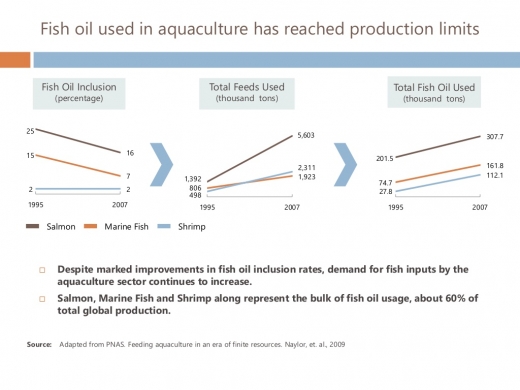 Many attempts to replace the key aminoacids found in fish meal have resulted in great improvements, and it some cases, a complete elimination or replacement with "analogs" that provide the required profiles with both natural and synthetic sources. It seems that the replication of the fats hasn't proven quickly to catch up. Technologies exist to produce such amino acids, algae being a great example. Unfortunately the production costs remain too high for a broadly adoption. Photo bioreactors are highly productive, but complex in their operation and key steps of the process are energy of raw material incentive. In particular production of the omega-3s highly needed for the development of many marine species, such as DHA and EPA are currently available, but their use remain in those applications that can afford the higher price tag.
Many attempts to replace the key aminoacids found in fish meal have resulted in great improvements, and it some cases, a complete elimination or replacement with "analogs" that provide the required profiles with both natural and synthetic sources. It seems that the replication of the fats hasn't proven quickly to catch up. Technologies exist to produce such amino acids, algae being a great example. Unfortunately the production costs remain too high for a broadly adoption. Photo bioreactors are highly productive, but complex in their operation and key steps of the process are energy of raw material incentive. In particular production of the omega-3s highly needed for the development of many marine species, such as DHA and EPA are currently available, but their use remain in those applications that can afford the higher price tag.
The need for alternative production systems of these omega-3s is therefore mandatory. With the ability to provide enough volume and at a cost parity to fish-oil. It seems that the majority of companies playing in this area have already committed to their particular organisms and production systems, arguably, a break-through technology will be required, as opposed to continuous improvement efforts, to achieve such goals.
A few years back, I had the opportunity to lead one of such efforts. At that time, conditions and structure of previously funded intellectual property led the venture to stop further development. Even when having the right team, the right strategy and enough capital to seed the project, it became an issue of protection of know how and risk profiles that made the investors consider alternative options. Time might present another opportunity, some of the preliminary patents have expired and there is a much greater understanding of the drivers to make it successful. I'm also sure many others are conducting research in this area and perceive fish-oil as the most critical hurdle for an explosion of aquaculture practices. At the end, what was considered then to be the greatest driver for success remain in place, perhaps it is as critical as it was considered then, ...and it won't stop been the key issue facing aquaculture until the availability of EPA and DHA are produced from more sustainable sources.